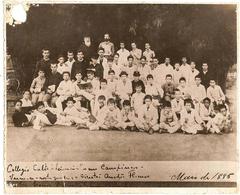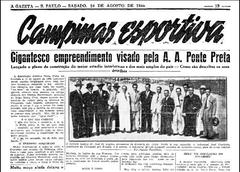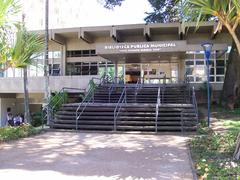Casa Grande e Tulha: Visiting Hours, Tickets, and Guide to Campinas’ Historical Gem
Introduction
Casa Grande e Tulha in Campinas, São Paulo, is one of Brazil’s most significant historical estates, offering visitors a rare opportunity to connect with the region’s colonial, agricultural, and urban evolution. Comprising two main structures—an 18th-century granary (Tulha) and a 19th-century main house (Casa Grande)—the site stands as a living testament to the transitions from sugarcane to coffee cultivation that shaped Campinas’ identity. This guide provides detailed and up-to-date information on Casa Grande e Tulha’s history, architectural features, visiting hours, ticketing, accessibility, and practical tips to help you plan an enriching visit to this iconic site.
Table of Contents
- Historical Background
- Architectural and Cultural Significance
- Visiting Casa Grande e Tulha: Practical Information
- Tour Experience and Accessibility
- Nearby Attractions
- Frequently Asked Questions (FAQ)
- Conclusion and Further Resources
Historical Background
Early Land Grants and Foundations
Casa Grande e Tulha’s origins are interwoven with the earliest chapters of Campinas’ history. The estate began with a sesmaria (land grant) awarded in 1732 to Antônio Maria de Abreu and João Bueno da Silva, a colonial strategy to populate and cultivate the interior of São Paulo (iabcampinas.org.br). Though the original grantees did not settle the land, it changed hands several times, integrating into Campinas’ early agricultural landscape along the Ribeirão das Campinas Velhas.
Construction and Evolution
- Tulha (Granary): Built between 1790 and 1795, the Tulha exemplifies the taipa de pilão (rammed earth) construction typical of the late colonial period. It served as storage for sugar products before the rise of coffee cultivation (campinas.com.br).
- Casa Grande (Main House): Erected around the 1830s, likely by Maria Felicíssima Miquelina de Abreu and Joaquim José Soares de Carvalho, the Casa Grande marks the region’s shift to coffee as the dominant crop (pt.wikipedia.org).
20th Century Decline and Preservation
By the late 20th century, the estate had dwindled in size. In the 1980s, architect and urbanist Antônio da Costa Santos (Toninho) acquired and painstakingly restored the site, bringing it to prominence in academic and conservation circles (iabcampinas.org.br). His efforts led to official protection at municipal, state, and federal levels, culminating in definitive listing by IPHAN in 2011 (gov.br).
Architectural and Cultural Significance
Construction Techniques
Casa Grande e Tulha is a rare, well-preserved example of taipa de pilão architecture. The thick, rammed earth walls provide thermal efficiency and durability, representing both Portuguese influence and adaptation to Brazilian resources (Diário do Turismo).
Layout and Function
The estate’s layout, with the main house and granary situated on landscaped grounds, reflects rural socio-economic hierarchies of 18th- and 19th-century Brazil. The Tulha was critical for storing and processing agricultural products, while the Casa Grande served as the residence and administrative center.
Symbolic and Academic Value
Casa Grande e Tulha symbolizes Campinas’ transition from a rural outpost to a major urban center. It stands as a hub for research, heritage education, and community memory, appearing in scholarly works and local initiatives (periodicos.puc-campinas.edu.br).
Visiting Casa Grande e Tulha: Practical Information
Location
- Address: Vila Lemos/Jardim Proença, Campinas, São Paulo
- Access: Best reached by public transit, taxi, or rideshare. Parking is limited due to the residential setting (A Cidade On).
Visiting Hours
- General Access: Casa Grande e Tulha does not operate with fixed public hours. Visits are arranged through special cultural events, educational programs, or by appointment with local heritage organizations. The site is typically closed to unscheduled visitors (A Cidade On).
Tickets and Admission
- Entry: Most visits are free but require advance booking or participation in scheduled tours and events. Some special programs may request donations or charge a small fee.
- How to Book: Contact the Instituto de Arquitetos do Brasil – Núcleo Campinas, the municipal cultural department, or check the official IPHAN announcement for event calendars and booking guidance.
Guided Tours
- Languages: Tours are typically in Portuguese; some guides may offer English if arranged in advance.
- Content: Guided visits provide in-depth historical, architectural, and cultural context, often led by historians or architects.
Tour Experience and Accessibility
On-Site Features
- Casa Grande: The main residence, built ~1830, features regular geometry and well-preserved original elements.
- Tulha: The granary, c.1790, is among Campinas’ oldest rural buildings.
- Gardens: Mature trees and a restored landscape provide a tranquil visitor experience.
Accessibility
- Mobility: The site has limited accessibility due to historic architecture—expect steps, narrow doorways, and uneven paths.
- Facilities: There are no commercial amenities or dedicated accessible restrooms. Visitors with mobility needs should inquire ahead for assistance.
Visitor Etiquette
- Respect restricted areas and preservation signage.
- Photography is often restricted indoors; always ask permission.
- No food or drink (except water) is allowed inside.
- Wear comfortable, closed-toe shoes for uneven surfaces.
Nearby Attractions
Expand your cultural itinerary with these nearby sites:
- Largo do Carmo: Campinas’ historic heart.
- Museu da Cidade: Municipal history museum.
- Bosque dos Jequitibás: Urban park with trails and a small zoo.
Frequently Asked Questions (FAQ)
Q: How do I visit Casa Grande e Tulha?
A: Visits are by appointment or during special events. Contact local heritage organizations to arrange access (A Cidade On).
Q: Are tickets required?
A: Most visits are free but require prior booking. Some events may have ticketed entry.
Q: What are the visiting hours?
A: There are no fixed hours. Visits occur during scheduled tours or events.
Q: Is the site accessible for people with disabilities?
A: Accessibility is limited; contact the caretakers in advance for possible accommodations.
Q: Can I take photographs?
A: Photography may be restricted indoors or in sensitive areas. Always ask for permission.
Conclusion and Further Resources
Casa Grande e Tulha is a vital symbol of Campinas’ layered history and cultural identity. Its rare preservation and ongoing research make it a must-visit for anyone interested in Brazil’s rural and urban evolution. To plan your visit, always consult heritage organizations for up-to-date access information, and take advantage of guided tours for the richest experience.
For more details, explore these authoritative sources:
- IPHAN Federal Heritage Listing Announcement
- Instituto de Arquitetos do Brasil – Núcleo Campinas
- Diário do Turismo: Architecture and Preservation
- A Cidade On: Visiting and Heritage Guide
- PUC Campinas Tulha Journal
- Jovem Pan News Campinas: Urban Studies
- ExploreCity.life: Campinas Overview





